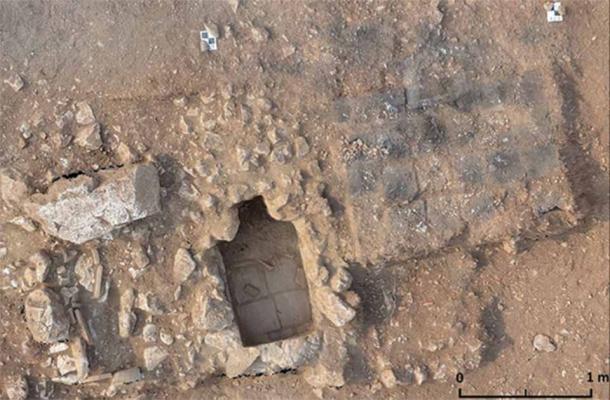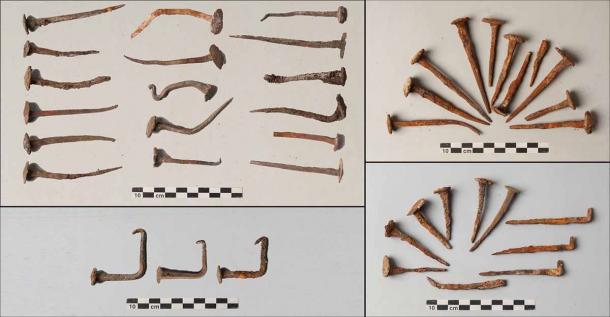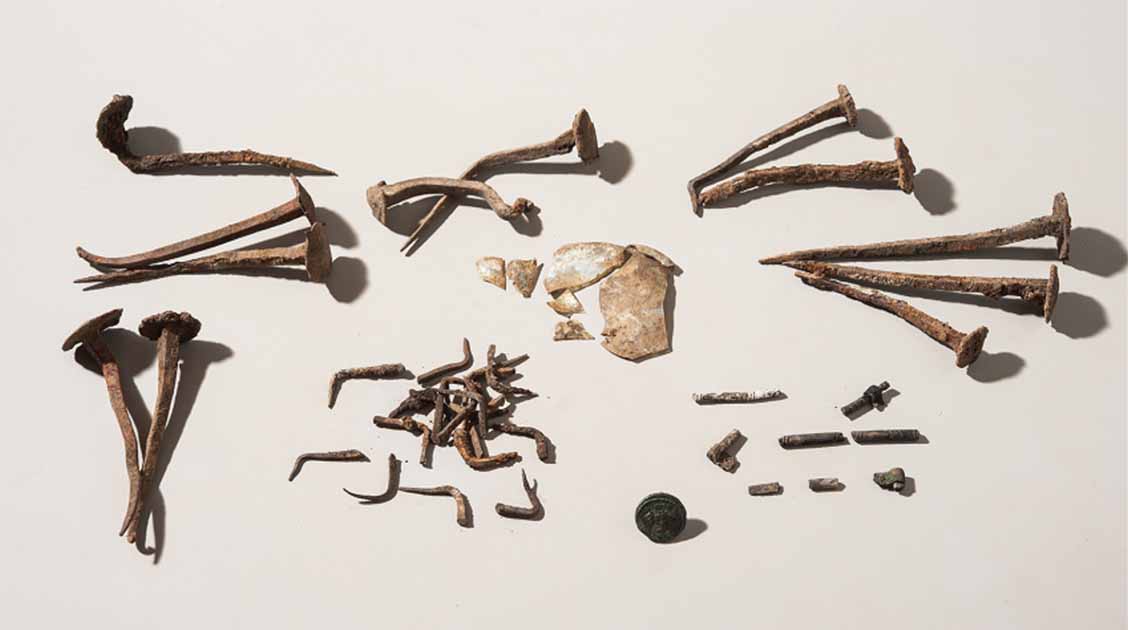“Dead Nails” Used in Roman Grave to Protect the Living from Restless Dead
Belgian archaeologists digging at the site of the ancient Roman city of Sagalassos in southwestern Turkey recently unearthed a most unusual burial. The tomb held the cremated remains of a man who’d lived in the second century AD, and what made this burial so remarkable is that it was sealed with two dozen bricks and an additional layer of plaster. Topping everything off, more than three dozen bent nails were sprinkled around the edges of the tomb as well, presumably as magic talismans meant to keep the deceased person trapped inside.
According to the Belgian archaeologists, all these steps were taken to prevent the return of a wandering spirit, who might have the capability of rising from the grave even after cremation. In an article just published in the journal Antiquity, the study authors explained that the ancient Romans feared the “restless dead” and would take magical precautions to protect themselves from these potentially dangerous beings.
"The burial was closed off with not one, not two, but three different ways that can be understood as attempts to shield the living from the dead—or the other way around," study first author Johan Claeys, an archaeologist at Catholic University Leuven (KU Leuven) in Belgium, told Live Science.
- Oldest Known Cremation in The Near East, From 7000 BC
- 20,000-Year-Old Woman Burned In Fiery Death Ritual
Claeys confirmed that the use of bricks and/or plaster to seal a grave, and the sprinkling of bent nails on a tomb, had all been seen before. But he noted that this was the first time a Roman grave had been found that used all three magical sealing methods simultaneously, implying that the people must have been especially fearful that this individual planned to return from the dead very soon.
A Strange Burial Indeed in Sagalassos
The ancient site of Sagalassos was continuously occupied for approximately 1,500 years, from the third century BC through the 13th century AD. It became a Roman possession in the first century BC, and rose to its greatest prominence during its Roman period.
The village and future city was constructed on the slopes of the Taurus Mountain range in what is now southwestern Turkey, and it was surrounded by lakes on all sides. Its remote geography has largely protected Sagalassos from looting and pillaging by antiquities thieves, and today it remains one of the best preserved ancient urban sites in the Mediterranean region.
Because the ancient city was so well preserved, archaeologists have been able to find numerous buildings and facilities constructed during Roman times, including a theater and a bath complex. Under the auspices of the ongoing Sagalassos Archaeological Research Project, excavations were carried out in cemeteries on the edges of the city, and many Roman-era cremation pyre remains and intact burials have been uncovered as a result of this work.
But none stand out like the “non-normative” cremation and subsequent burial of the man sealed in with bricks, plaster and bent nails. In addition to the anomalous presence of the masonry layers and magical talismans, the tomb was also unusual because the cremation and burial took place in the same spot (the ashes and unburned remnants of cremated bodies were normally entombed elsewhere). The bricks and plaster were actually lain over the burned body while the funeral pyre was still hot and smoking, highlighting how determined the people of Sagalassos were to get the person buried and sealed in as quickly as possible.

Cremation area (right) and two middle-imperial Roman tombs under excavation. (© Sagalassos Archaeological Research Project/ Antiquity Publications Ltd)
Looking inside the grave, the Belgian archaeologists found both ashes and charred but not fully burned bones, the latter of which they used to confirm that the individual was male. They also found a reasonably rich collection of grave goods that suggested the deceased man was beloved by his family. The items buried beside his remains included finely-made ceramic and glass vessels, a Roman coin, pieces of a skillfully woven basket and the remnants of some food.
"It seems clear that the deceased was buried with all appropriate aplomb," Claeys stated. "It seems likely that was the suitable way of parting with a loved one at the time."
Claeys thinks that the man’s family were responsible for all aspects of his burial. They resorted to magical means to make sure he stayed safe, sound and secure in his grave, presumably until the time came for him to complete his transition to the afterlife.
- “Rediscovered” Judean Roman Coffins Decorated For Afterlife Protection
- Green-Boned Baby Clasps A Copper Ticket to The Afterlife
Fear the Walking Dead
“The combination of nails and bricks designed to restrain the dead with the sealing effect of the lime strongly implies a fear of the restless dead,” the authors of the new study wrote in their Antiquity article. “Regardless of whether the cause of death was traumatic, mysterious or potentially the result of a contagious illness or punishment, it appears to have left the dead intent on retaliation and the living fearful of the deceased's return.”

Dead nails. Upper left) bent and twisted nails from the primary cremation at Site F; lower left) nails from an ash pit with cremation remains at the same site; right) examples of coffin nails from two individual separate inhumations from the same site (© Sagalassos Archaeological Research Project/Antiquity Publications Ltd)
It is certainly possible that the grave was done to suppress a vengeful spirit. But it’s also possible that the person’s family members were worried about their loved one being exploited in the afterlife by a practitioner of the black arts.
In the Greek and Roman black magic traditions of antiquity, a fear of ghosts or restless spirits provided a frequent motivation for spellcasting. People feared the damage restless spirits might inflict if they found a way to return to the land of the living, and sometimes actions needed to be taken to ensure they stayed where they were.
The primary risk was from the spirits of those who’d died prematurely, by accident, murder, sudden illness or unexpected natural disaster. They would remain trapped in the earthly realm until the date of their scheduled natural deaths arrived, it was said, after which they would finally be free to depart for the afterworld.
But until that day of liberation, such spirits were vulnerable to the evil intentions of necromancers, a type of wizard or witch who could raise the dead and compel them to do their bidding. Supposedly, the necromancer would create a curse tablet made of papyrus, and then roll it up and sneakily insert it into the grave of a prematurely deceased spirit. Afterwards they would raise their poor victim from the dead and force them to become their servant.
In contrast to their concern with ghosts, the Romans were not particularly worried about reanimated zombies (cremation was the norm in the ancient Roman world, which pretty much eliminated the zombie risk) or vampires. So it seems possible (and maybe likely) that the special precautions taken to keep the man sealed inside the newly discovered grave in Sagalassos were taken out of a fear that he might be exploited by a necromancer. If this is the case, the man’s family would have been trying to protect both their loved one and their community, through the use of a type of magic that was commonly practiced in the ancient Greek and Roman world.
Top image: Dead nails found in the Roman grave in Sagalassos to protect the living or the dead. Source: © Sagalassos Archaeological Research Project/ Antiquity Publications Ltd
By Nathan Falde


















Comments
From the article, “...three dozen bent nails were sprinkled around the edges of the tomb as well, presumably as magic talismans meant to keep the deceased person trapped inside.”
I’m guessing, by the absurdity of this, that we’re all supposed to finally wake up to the joke that archaeology is, and has always been? Or what aren’t I seeing?
Nobody gets paid to tell the truth.